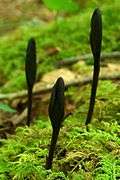Waxcap grassland

Waxcap grassland is short-sward, nutrient-poor grassland that supports a rich assemblage of larger fungi, particularly waxcaps (Hygrocybe spp), characteristic of such habitats. Waxcap grasslands occur principally in Europe, where they are declining as a result of agricultural practices. The fungal species are consequently of conservation concern and efforts have been made in the United Kingdom and elsewhere to protect both the grasslands and their characteristic fungi.
Background
The association of waxcaps with unimproved (nutrient-poor) grasslands was first noted in 1949 in the Netherlands,[1] but current interest was stimulated by a series of papers published by Dutch mycologist Eef Arnolds in the 1980s.[2][3] Arnolds not only confirmed the association of waxcaps with unimproved grasslands, but also noted the rapid decline in such habitats in the Netherlands.[3] Similar studies were subsequently undertaken elsewhere in Europe, initially in Denmark[4] and the United Kingdom.[5]
Definition and description
Waxcap grasslands are characterized by being unimproved (unfertilized and nutrient-poor), short-sward (through grazing or mowing), moss-rich, and long-established (not recently sown).[6] They occur in both upland and lowland areas and may be on acidic, neutral, or calcareous soil. They support a wide range of characteristic larger fungi, but may not be equally species-rich in plants.[6]
Characteristic species
Larger fungi characteristic of waxcap grasslands include agarics belonging to the genera Hygrocybe (waxcaps), Entoloma (pinkgills), Dermoloma, Porpoloma, and Camarophyllopsis, clavarioid fungi (club and coral fungi) belonging to the genera Clavaria, Clavulinopsis, and Ramariopsis, and earthtongues belonging to the genera Geoglossum, Microglossum, and Trichoglossum.
The "CHEG" assessment system
In 1995, Rald proposed a simple count of the number of Hygrocybe species present at a given site in order to assess its value as a waxcap grassland. He suggested that the presence of 17 or more species meant the site was of national importance, 9-16 species of regional importance, 4-8 species of local importance, and 3 or fewer of no importance.[4] A year later, this system was modified by Rotheroe and others to include all the characteristic macrofungi and not just waxcaps.[5] Known as the "CHEG" system, this is widely used in survey work today. The acronym "CHEG" stands for the main groups of relevant fungi: C - the clavarioid species; H - Hygrocybe species; E - Entoloma species; and G - the Geoglossaceae (earthtongues).
Conservation
This decline in waxcap grasslands has been mainly the result of agricultural improvement of pastures by ploughing and reseeding, by manuring, and by the use of fertilizers and other chemicals.[3][6] In 1988, Arnolds estimated that only some 200 ha of unimproved waxcap grasslands remained in the Netherlands.[2] As a result, both the grasslands and the larger fungi typical of such grasslands are of conservation concern, with the majority of species featuring in one or more national red lists of threatened fungi in Europe.[5]
In the United Kingdom, recent survey work has shown that surviving waxcap grasslands are more extensive than in many other European countries, thanks mainly to large areas of unimproved upland sheep pastures and also to many unimproved lawns (especially in churchyards and country houses) and amenity grasslands. Nonetheless, five species characteristic of waxcap grasslands - Entoloma bloxamii, Hygrocybe calyptriformis, Hygrocybe spadicea, Geoglossum atropurpureum, and Microglossum olivaceum - are or have been the subject of national Biodiversity Action Plans[7] and waxcap grasslands as a specific habitat are the subject of several local Biodiversity Action Plans.[8][9][10] Waxcap grassland surveys have been undertaken by the British Mycological Society,[5] the National Trust,[11][12] Plantlife,[13] and the various national conservation bodies.[14][15] As a result, several waxcap grassland sites, such as the banks of Llanishen and Lisvane Reservoirs in Cardiff[10][16] and the lawns of Roecliffe Manor in Leicestershire,[17] have been designated Sites of Special Scientific Interest, affording them some legal protection. A leaflet on managing waxcap grasslands in Britain and Ireland has been published by Plantlife and the Fungus Conservation Forum.[18]
References
- ↑ Schweers ACS. (1949). "Hygrophorusweide, een associatie". Fungus. 19: 17–18.
- 1 2 Arnolds E. (1988). "The changing macromycete flora in the Netherlands". Transactions of the British Mycological Society. 90: 391–406. doi:10.1016/s0007-1536(88)80148-7.
- 1 2 3 Arnolds E. (1989). "The influence of increased fertilization on the macrofungi of a sheep meadow". Opera Botanica. 100: 7–21.
- 1 2 Rald E. (1995). "Vokshatte som indikatorarter for mykologisk verifulde overdrevslokaliteter". Svampe. 11: 57–65.
- 1 2 3 4 Rotheroe M, Newton A, Evans S, Feehan J (1996). "Waxcap-grassland survey". The Mycologist. 10: 23–25. doi:10.1016/s0269-915x(96)80046-2.
- 1 2 3 Griffith GW, Easton GL, Jones AW (2002). "Ecology and diversity of waxcap (Hygrocybe spp) fungi". Botanical Journal of Scotland. 54: 7–22. doi:10.1080/03746600208685025.
- ↑ UK BAP priority fungi species http://jncc.defra.gov.uk/page-5165
- ↑ Powys waxcap grasslands action plan https://docs.google.com/viewer?a=v&q=cache:gj82-CHCMdkJ:www.powys.gov.uk/uploads/media/waxcap_grasslands_bi.pdf+waxcap+grasslands+action+plan&hl=en&gl=uk&pid=bl&srcid=ADGEESh5EYXX46INISiBoplBHA-m-93azOj4YDeGAvSMOvN2o6F67ruUI_E1fTlFqHGdBYOTiddzX-xxL0dNwMpCsrgMj33BOJYWMup6U7aZBoB_Be3ohE3YwwbPyFUGU-WXoXg4OkNS&sig=AHIEtbRIjnhYSv78l7Qcq1BpalNgQjvHtg
- ↑ Durham - waxcap grasslands action plan http://www.durhambiodiversity.org.uk/Web%20page%20plans/Waxcap%20Grasslands%202006.htm
- 1 2 Provisional atlas of waxcap fungi Hygrocybe in Cardiff http://www.cardiff.gov.uk/objview.asp?object_id=14068
- ↑ Anon (2007). Waxcap watch (leaflet) (PDF). National Trust. p. 6.
- ↑ National Trust - waxcap survey results http://www.nationaltrust.org.uk/main/w-global/w-news/w-latest_news/w-news-waxcapresults.htm
- ↑ Pink waxcap survey http://www.plantlife.org.uk/uploads/documents/Hygrocybe_calyptriformis_species_dossier.pdf
- ↑ Evans S (2003). "Waxcap-grasslands - an assessment of English sites". English Nature Research Reports. 555: 1–49.
- ↑ Scottish Fungi - grassland fungi project http://sites.google.com/site/scottishfungi/conservation/grassland-fungi
- ↑ Llanishen and Lisvane reservoir embankments Site of Special Scientific Interest https://docs.google.com/viewer?a=v&q=cache:igqP5IkErt8J:www.ccw.gov.uk/idoc.ashx?docid%3Da012b262-9ee5-4c9f-a5e3-c4e9172d4920%26version%3D-1+sms+english+llanishen&hl=en&gl=uk&pid=bl&srcid=ADGEESjhoPXLHbMoiXZ_j4uC2sJ63nQkIZXAgR9uJNrOjkEcs9dVG5na-es8bjdg0vbLhQ1YGMcdk8HO9Zd_VdVc97Aw-NLRTkxlicnahUN6lQbZ3uDv24WaH78T8Pgl6uzAKuOl3cmN&sig=AHIEtbQCbzzuAGmKGemYiOezzMQfbLZNqw&pli=1
- ↑ Roecliffe Manor lawns http://www.english-nature.org.uk/citation/citation_photo/2000453.pdf
- ↑ Anon. Grassland gems: managing lawns and pastures for fungi (leaflet) (PDF). Plantlife. p. 4.




